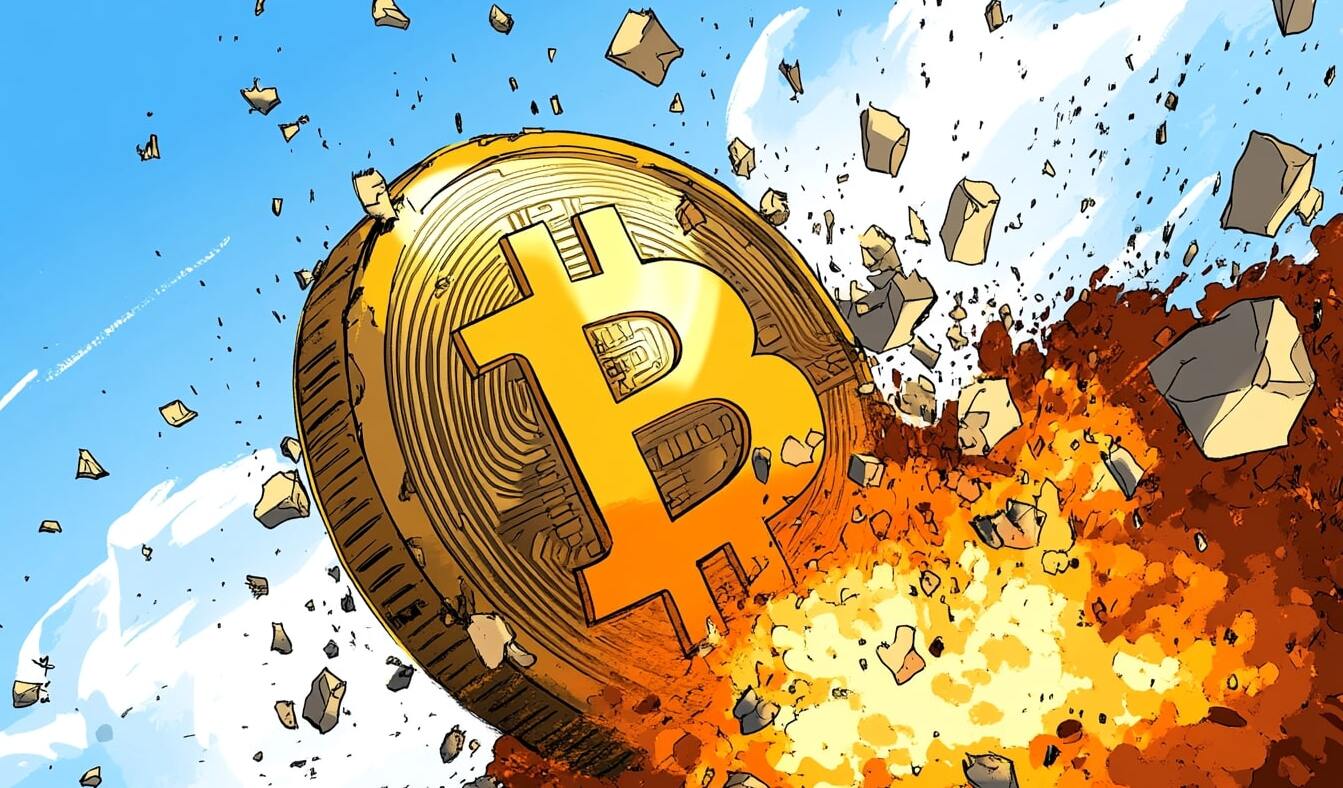
Bitcoin Struggles at $61,000 Amid Institutional Outflows
Stablecoin Market Surge Offers Hope as ETFs See Consecutive Outflows, Leaving Bitcoin Vulnerable | That's TradingNEWS
Bitcoin Price Faces Pressure Amid Stablecoin Surge, ETF Outflows, and Macro Concerns
Institutional Outflows and Impact on Bitcoin (BTC)
Bitcoin (BTC) continues to face selling pressure as it hovers around the $61,000 mark, following a close below the critical support level of $62,000. The downward move reflects softening demand from institutional investors, particularly as US Spot Bitcoin Exchange Traded Funds (ETFs) recorded two consecutive days of outflows. These outflows, totaling $30.60 million according to Coinglass data, indicate a broader hesitation in the market, raising concerns over Bitcoin's short-term trajectory.
Despite the pressure, Bitcoin's price finds temporary support around the 200-day Exponential Moving Average (EMA) at $60,024. If this support breaks, BTC may see a deeper pullback toward the $57,493 level, a potential 4% drop from its current price. The Relative Strength Index (RSI) hovering below the neutral 50 mark further highlights the bearish momentum, with recovery prospects hinging on whether Bitcoin can reclaim the $62,125 resistance level.
CPI Data and Federal Reserve Influence on Bitcoin
Macroeconomic data is weighing heavily on Bitcoin's price as investors digest inflationary signals and the Federal Reserve's stance on interest rates. The latest Consumer Price Index (CPI) report showed a 0.2% rise for the month of September, exceeding economists' expectations. Core CPI, which strips out volatile categories like food and energy, also posted a 0.3% increase, adding to market jitters.
These inflation figures suggest that the Federal Reserve may hold off on further rate cuts in November, casting a shadow over speculative assets like Bitcoin. High-interest rate environments typically curb liquidity, making it difficult for risk assets such as cryptocurrencies to sustain rallies. The CME FedWatch tool now reflects a shift in market sentiment, with traders increasingly betting on a 25 basis point cut rather than the initially expected 50 basis points.
Speculation Over Potential $4 Billion Bitcoin Sale
Adding to the downside risk, the U.S. Supreme Court recently upheld a ruling that could lead to the liquidation of 69,370 Bitcoin—approximately $4 billion—seized from the Silk Road marketplace. Although a liquidation event is not imminent, market participants remain cautious about the possibility of such a massive selloff.
This potential sale could echo the impact of token distributions by the defunct crypto exchange Mt. Gox earlier this year, which led to a temporary dip in Bitcoin prices. Any significant liquidation would likely put additional downward pressure on Bitcoin, heightening market volatility.
Geopolitical Concerns and Institutional Demand for Bitcoin
Bitcoin’s struggles are not solely tied to economic data. The ongoing geopolitical tensions in the Middle East, particularly the missile attacks between Iran and Israel, have contributed to market instability. Although these developments have led to short-term price spikes in crude oil, the broader cryptocurrency market has remained vulnerable to the uncertainty.
Bitcoin briefly surged above its 100-day and 200-day moving averages, reviving bullish sentiment. However, this momentum was short-lived, with the cryptocurrency encountering strong resistance near the $66,000 mark. Selling pressure at this level highlights market reluctance to push Bitcoin higher, despite the underlying bullish trends in stablecoin accumulation.
The Coinbase Premium Index, a key indicator of U.S. institutional demand, currently shows negative values, suggesting that large traders are either selling or refraining from accumulating Bitcoin. This bearish sentiment is evident as the index continues to point toward weaker demand from U.S.-based institutions, making it difficult for Bitcoin to break through critical resistance levels in the short term.
Stablecoin Market Capitalization: A Glimmer of Hope?
Amid the bearish sentiment, the rising stablecoin market capitalization offers some optimism for a future Bitcoin rally. Stablecoin liquidity has surged in recent months, with the total market capitalization of major U.S. Dollar-backed stablecoins reaching $169 billion, a 31% increase year-to-date (YTD). This uptick in stablecoin balances on exchanges could signal that liquidity is primed for a broader market recovery.
USDT reserves on exchanges have jumped from $9.2 billion in January to $22.7 billion, representing a 146% increase, even as Bitcoin prices have remained relatively stagnant. This growth in stablecoin reserves suggests that investors are waiting on the sidelines, ready to deploy capital when market conditions become more favorable. However, this liquidity remains untapped for now, as Bitcoin struggles to regain momentum.
On-Chain Metrics and Bitcoin’s Future Price Action
Bitcoin’s on-chain metrics also present a mixed picture. The CryptoQuant report points to an increase in stablecoin balances on exchanges as a positive sign for Bitcoin’s medium-term outlook. Nevertheless, the negative Coinbase Premium Index and declining ETF inflows indicate that U.S. institutional demand has yet to pick up.
Bitcoin’s price currently remains in a critical support zone between $60,000 and $62,000. If the price breaks below $60,000, it could trigger a further decline toward the $52,000-$55,000 range, which would mark a substantial mid-term correction. Conversely, a breakout above $62,125 could invalidate the bearish thesis, paving the way for Bitcoin to attempt a retest of the $66,000 resistance level.
Market Sentiment and Short Seller Activity
Despite the gloomy price action, short sellers have not entirely dominated the market. Data from Standard Chartered suggests that the latest rally was driven by short-covering, as bearish traders scrambled to lock in profits amid rising geopolitical risks. However, the overall market sentiment remains bearish, with the bank’s positioning index still deeply negative.
Standard Chartered’s proprietary crude oil positioning index, which tracks sentiment among oil traders, also shows little change, reinforcing the view that broader macroeconomic concerns are keeping risk appetite subdued. Even with potential supply shocks in the Middle East, traders remain wary of aggressively long positions in Bitcoin or other speculative assets.
Bitcoin’s Derivatives Market and Spot ETF Trends
The derivatives market for Bitcoin has been relatively balanced, with futures premiums holding steady around 8%. This suggests that demand for leverage is neutral, neither overwhelmingly bullish nor bearish. The lack of conviction among derivatives traders is further supported by the steady outflows from Bitcoin spot ETFs, which have seen $335 million in net outflows since the start of October.
These outflows from institutional products highlight a broader trend: as interest rates remain elevated and liquidity is scarce, investors are cautious about committing large sums to Bitcoin in the short term. Until there is a clear catalyst—whether in the form of a geopolitical event, macroeconomic shift, or institutional inflow—Bitcoin may struggle to break free from its current price range.
Conclusion: Bitcoin’s Next Steps
Bitcoin finds itself at a crossroads, navigating a complex landscape of macroeconomic pressures, declining institutional demand, and geopolitical risks. With support holding at $60,024, Bitcoin could enter a consolidation phase, but any break below this level could trigger a sharp decline toward $55,000.
On the flip side, a breakout above $62,125 could reignite bullish momentum, especially if stablecoin liquidity begins to flow into the market. Investors and traders must keep a close eye on both macroeconomic developments and on-chain metrics to gauge the next move in Bitcoin’s price action.
For now, Bitcoin remains vulnerable, but the rising stablecoin market capitalization and the potential for renewed institutional interest could provide the necessary fuel for a future rally. Until then, caution remains the dominant theme.
That's TradingNEWS
Read More
-
UCO ETF Price Forecast: Can NYSEARCA:UCO at $18.57 Ride a 2026 Oil Squeeze?
18.12.2025 · TradingNEWS ArchiveStocks
-
XRPI at $10.50 and XRPR at $14.93 Hit XRP ETF Lows While XRP-USD Holds $1.84 After 30 Days of Inflows
18.12.2025 · TradingNEWS ArchiveCrypto
-
Natural Gas Price Forecast: Henry Hub Holds Around $4 as EIA Draw Hits 167 Bcf
18.12.2025 · TradingNEWS ArchiveCommodities
-
USD/JPY Price Forecast: Pair Holds Above 155 As BoJ And US CPI Set Up A Major Break
18.12.2025 · TradingNEWS ArchiveForex

















